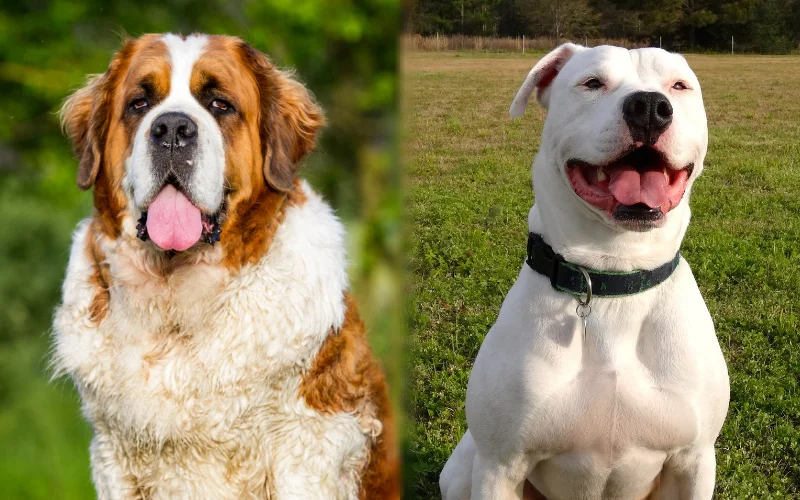St. Bullnard (St. Bernard Pitbull Mix): Pictures, Care, Temperament & Traits

By Misty Layne
Updated on

Click to Skip Ahead
If you’ve been searching for a new dog to adopt, you’ve probably looked at many breeds by now. But have you considered the St. Bullnard? What exactly is a St. Bullnard? It’s a designer dog breed created from a Saint Bernard and Pitbull. It’s a perfect mix of the two, so if you were interested in either at some point but couldn’t decide which to get, the St. Bullnard could be an excellent fit.
You should learn more before deciding to adopt one, though, such as how to take care of it and what kind of training and grooming needs it has. We’ve gathered everything you need to know, so you can decide whether this is the dog for you!
| Height: | 20–27 inches |
| Weight: | 50–120 pounds |
| Lifespan: | 8–11 years |
| Colors: | Fawn, tan, brindle, brown, red, blue, black, white |
| Suitable for: | Active families, active singles |
| Temperament: | Gentle, energetic, strong-willed, smart |
The St. Bullnard is a hybrid breed that comes from the St. Bernard and Pitbull. These dogs are friendly and affectionate and love being with their families. The breed is also intelligent and eager to please, so training them isn’t too difficult. Plus, these pups are cute as can be!
St. Bullnard Characteristics
St. Bullnard Puppies
Unfortunately, it won’t be easy to locate a St. Bullnard puppy as the breed isn’t hugely popular. Your best bet will be finding a reputable St. Bullnard breeder to get one, but there aren’t many of those out there. It’s difficult to say how much one of these dogs would cost via breeder, but since there aren’t many available, it will probably be on the expensive side.
There’s a small chance you could find one of these dogs at your local shelter or an online adoption site, so you might want to check those places first. But again, chances are slim.

Temperament & Intelligence of the St. Bullnard 🧠
Most St. Bullnards will inherit a healthy mix of traits from both parent breeds. Generally speaking, this breed is gentle and exceptionally friendly. They love to meet new people! That friendliness might not make them the best guard dog, though; however, they are alert, constantly aware of what’s happening around them, and protective of their families.
If you’re concerned about aggressive tendencies coming from the Pitbull parent, well, Pitbulls being naturally aggressive is a common misconception. Pitbulls have a history of being used in dog fighting, but that’s really more human fault than dog. And in cases where Pitbulls have bitten people or animals, you’ll most often find that there was a severe lack of training involved. So, the St. Bullnard isn’t a naturally aggressive breed.
Both of the parent breeds of the St. Bullnard are relatively intelligent, so this breed typically is quite clever. Luckily, that will make training them a bit easier!
Are These Dogs Good for Families? 👪
The St. Bullnard is an affectionate dog that enjoys spending time with its family and, in fact, doesn’t enjoy being left on its own. Though they enjoy playing with older people more, they will also enjoy playing with children. Just ensure you always supervise when children and the St. Bullnard are playing together. Due to its large size, an overexuberant pup could accidentally knock over a little one.
Don’t skimp out on socialization and training, though! Despite being friendly by nature, your pup will still need to be socialized early on to fully integrate with the family.
Also, be aware that some states, cities, and towns ban having Pitbulls as pets, so you should check laws where you live to see if any exist and whether the St. Bullnard falls under them.
Does This Breed Get Along with Other Pets?
Whether a St. Bullnard gets along with other animals depends on whether it takes more after the St. Bernard or Pitbull. St. Bernards are generally okay with other animals in the home, but Pitbulls aren’t always friendly with other pets. Plus, the strong prey drive of a Pitbull means the dog will be more likely to go after smaller animals, such as felines. However, with early socialization and training, you’ll have better chances of living in a peaceful multi-pet household.
Things to Know When Owning a St. Bullnard:
There’s always a lot you should know before adopting a dog, and the St. Bullnard is no different. You need to know how much daily exercise these dogs need, what their grooming needs are, and more to make a properly informed decision about owning one!
Food & Diet Requirements 🦴
Your St. Bullnard will need high-quality dog food that’s rich in protein. Most likely, getting breed-specific dog food will be best. As for how much to feed your pup, it’s wise to talk with your vet. All dogs are different, even those of the same breed, so your dog may need more or less to eat than another St. Bullnard.
One important thing to know is that St. Bullnards are prone to getting bloat, which can be fatal. So, if your pet is eating too quickly at mealtimes, you should consider getting a puzzle feeder to help slow it down and lessen the risk of bloat.
Exercise 🐕
How much exercise your St. Bullnard requires will depend partially on which parent it takes after most. A St. Bullnard that takes more after a Pitbull will need 45–60 minutes of exercise a day. Anything from a long walk to a quick jog or a romp through the backyard should suffice. However, if your St. Bullnard is more like the St. Bernard, it won’t be as energetic and will only need to be exercised for about a half hour a day.
The St. Bullnard can be prone to obesity, though, so make sure your pup is getting adequate exercise!
Training 🎾
Training and socialization are vital when it comes to the St. Bullnard, so you’ll want to begin on those the moment you bring your pup home. Because this breed is intelligent and eager to please, you shouldn’t have a lot of trouble with training; just remember to only use positive reinforcement. That means plenty of praise and treats for your pup when it does well!
If you have any issues with training your St. Bullnard, look into getting a professional trainer to help. Just giving up and skipping out on training will benefit no one!
Grooming ✂️
The majority of St. Bullnard’s seem to end up with a medium-length coat, which is great for you as it’s simpler to groom. A medium-length coat just needs to be brushed once a week to help reduce shedding. However, sometimes this breed will end up with the coat of the St. Bernard, which is longer and needs more grooming. In this case, you’ll need to brush your pup twice or thrice weekly.
You’ll also need to bathe your pet when it runs through a mud puddle or rolls around in the dirt. Just don’t bathe it too often, as this can dry out skin and strip oils from the dog’s coat. You’ll also need to check your dog’s ears regularly and clean them out as needed, brush their teeth twice a week, and keep their nails trimmed and neat.
Health and Conditions ❤️
St. Bullnards might not have the longest lifespans, but they do tend to be generally healthy. But that doesn’t mean there aren’t some health conditions they could inherit from their parent breeds. Below are some of the most likely health issues a St. Bullnard might develop.
- Cataracts
- Allergies
- Hip dysplasia
- Aortic stenosis
- Bloat
Male vs Female
There isn’t much difference between male and female St. Bullnards other than the fact the male will be a few inches larger and a few pounds heavier. Both should have similar personality traits, like being friendly and eager to please. Whether a female or male is right for you mostly comes down to your personal preference.
Also, remember, when it comes to getting your dog fixed, it’s always more expensive to spay than neuter!
3 Little-Known Facts About the St. Bullnard
What else do we know about the St. Bullnard breed? Here are three facts about the St. Bullnard that you might not have known!
1. The St. Bullnard is a newer hybrid breed.
Honestly, no one seemed quite sure when this breed appeared on the scene. But we do know that it’s relatively new.
2. The St. Bullnard suffers from separation anxiety.
One thing you certainly don’t want to do with this breed is leave it on its own for long periods. The St. Bullnard is prone to separation anxiety, which could lead to lots of barking or destructive behavior.
3. St. Bullnards will either be quite vocal or relatively silent.
You never know what you’ll get when it comes to how loud a St. Bullnard will be. If the pup takes more after the Pitbull, it will be vocal and bark more. Those who take after the St. Bernard will seldom bark as the St. Bernard is a much quieter dog.
Final Thoughts
The St. Bullnard is a hybrid breed that comes from the St. Bernard and Pitbull. As such, these pups have qualities of both, making them sweet, friendly dogs that love their families immensely. Unfortunately, there aren’t many St. Bullnard’s out there currently, but hopefully, that will change as the breed becomes more popular.
Featured Image Credit: Left – Aneta Jungerova, Shutterstock | Right – CrystalHeadbandz, Pixabay













